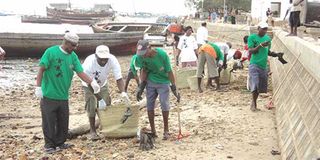Tourism stakeholders commit to tackle solid pollution in Lamu

Environmentalists cleaning the beaches in Lamu. LaMCoT has also taken part in clean-up to removes plastics which are hazardous to the sea turtles and the environment. PHOTO | KALUME KAZUNGU | NATION MEDIA GROUP
Julia Daan, a tourist from the Netherlands, is a frequent visitor to Lamu Island.
But she detests visiting the Lamu seafront because of the pollution and prefers the Shela beach side, which is cleaner.
“The beach in Shela is always clean and attractive. But the Lamu Old town seafront is dirty and discourages us from visiting there,” she told Nation.Africa.
Millie Charlie, a visitor from the United Kingdom, explained that while his intention was to relax under blue skies, in clear waters and on white sandy beaches, the Lamu seafront is the opposite.
“I prefer Lamu’s Shela beaches because you can spot a plastic disposal bin placed on the sides for you to dispose of that water bottle in your hand,” he said.
“This is contrary to Lamu Old Town, where people can be seen throwing plastic water bottles in the ocean or dropping them anyhow along the seafront without the slightest care.”
Lamu has some of the world’s most beautiful beaches, but a few are paying a heavy price for plastic pollution.
This has forced the travel and tourism industry to take action to reduce the plastic footprint and encourage locals and tourists to do the same.
A 40-day initiative to clean up the beaches has been launched by the Unesco regional office for eastern Africa in collaboration with the National Museums of Kenya (NMK).
Other partners are the Kenya Tourism Board (KTB), the Lamu public health office, local administrators, the Flipflopi Project and local community-based organisations.
The cleanup campaign, called Refuse, Reuse or Recycle Plastics, seeks to boost and safeguard the status of Lamu as a World Heritage site by keeping the surroundings clean for sustainable tourism.
Unesco’s Faith Manthi noted that the campaign also seeks to ensure there is a total ban on single-use plastics in Lamu Old Town.
She said that in 2019, before Covid-19 hit the world, more than 500 million tourists visited African countries, including those with World Heritage sites and destinations.
In 2020, at the peak of the pandemic, there was a major decline of between 79 percent and 81 percent.
The one-month clean-up campaign, she said, is part of post-Covid-19 strategies to help boost Lamu’s image so as to attract more visitors to the archipelago.
“Let’s embrace a clean environment by ensuring we totally ban single-use plastics in order to reduce or end the problem altogether in our World Heritage site,” she said.
“Plastic waste can corrode this World Heritage site and discourage tourists from visiting the destination.”
Mohammed Mwenje, the NMK curator in charge of Lamu, said the campaign also seeks to map all the renowned careless waste disposal hotspots in Lamu Old Town.
They include Mkomani’s Kanu office area, the Langoni historic graveyard, and the Old Town seafront.
Flipflopi representative Linet Aloo called on residents to desist from haphazard disposal of solid waste, particularly plastics.
“A Flipflopi baseline survey indicates that Lamu town alone produces 30 tonnes of plastics daily,” Ms Aloo.
“Flipflopi only handles 15 tonnes per day, meaning the remaining 15 tonnes lie there in our environment. Let’s join hands to end the plastic menace in Lamu.”
Kenya has seven natural and cultural sites on the Unesco World Heritage list.
They are Lamu Old Town, Fort Jesus in Mombasa, Mt Kenya National Park and Forest, the Kenya Lake System in the Rift Valley, Turkana
National Parks, Thimlich Ohinga in Migori, and the Sacred Mijikenda Kaya Forests on the Coast.





